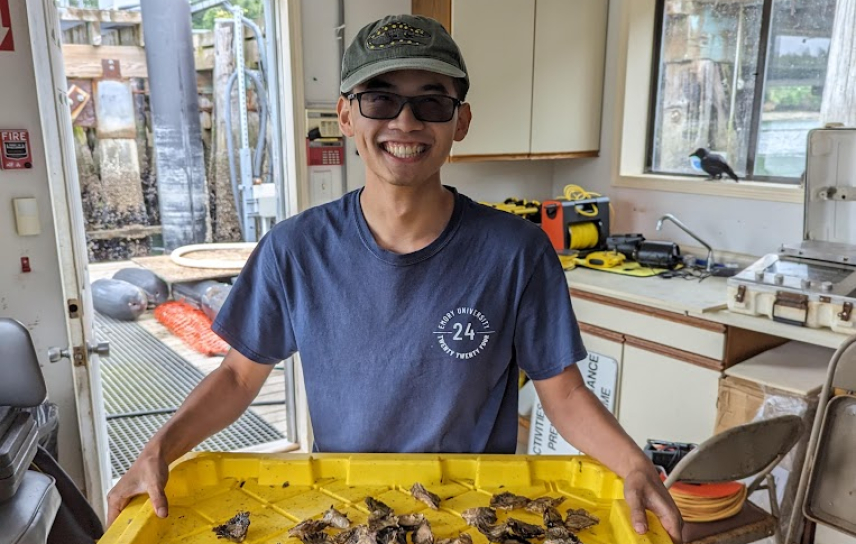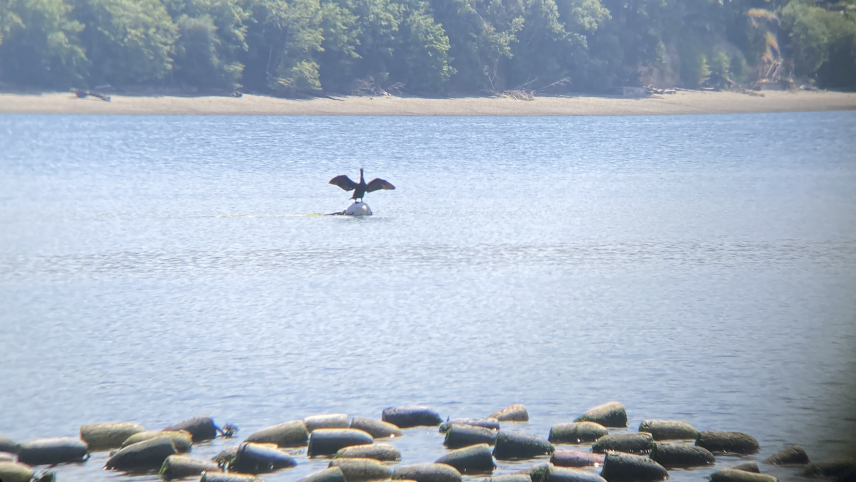Shellfish growers in the Pacific Northwest are seeing a rise in mass die-off events in their crops of Pacific oysters (Crassostrea gigas), with growing concerns that such events may be worsened with climate change and ocean acidification. During his 2023 Hollings internship with the Northwest Fisheries Science Center Ocean Acidification Lab, Nicholas Chang worked on a project that aims to improve the resiliency of oyster aquaculture operations to these threats. As part of the project, which is a partnership between NOAA, the University of Washington, and the Baywater Shellfish Company, Nick studied oysters at shellfish farms in Washington’s Puget Sound to determine whether diploid and triploid oysters respond differently to environmental stressors such as heightened water temperatures or lowered pH.

Diploid versus triploid oysters
Diploid oysters, such as those you might find in the wild, become watery and thin when they reproduce during the summer, which makes them less tasty and enjoyable for consumers to eat. Triploid oysters possess three sets of chromosomes instead of two sets like “natural” diploids, and are sterile, meaning that they don’t reproduce during the summer months. They offer farmers and consumers an alternative to diploids that can be sold and enjoyed during the summer. Triploids used in the industry also tend to grow faster than diploids. Unfortunately, they’re also more susceptible to summer mass die-off events, which are thought to be caused by environmental stressors such as extreme heat, ocean acidification, or hypoxia.

Nick’s project
To try to identify the drivers behind these die-off events, Nick worked with others to measure the growth and mortality, or death, rates of diploid and triploid oysters at four different oyster farms in the Puget Sound. In addition, he collected oysters from each site and measured their oxygen consumption rates in the lab. Understanding respiration rates is important because heightened oxygen consumption indicates that oysters are experiencing some form of stress. Abnormally low oxygen consumption isn’t good either–and it indicates that the oysters could be shutting down and about to die. Nick also analyzed water samples from each site to see how pH and alkalinity, two parameters important to understanding ocean acidification, varied in different parts of the Sound.
Growing up in Wisconsin and attending school in a landlocked Atlanta, I’ve always been interested in aquatic ecosystems, but have mostly worked with freshwater and have struggled to find hands-on opportunities to study marine ecology. The Hollings program gave me the opportunity to learn from my mentors, my peers, and the tidelands, equipping me to tackle complex questions in spatial ecology across diverse study systems.
The impact of Nick’s work
Nick’s measurements, along with the results of a series of laboratory experiments, will be used to map the costs and benefits of planting diploid vs. triploid oysters in different areas based on their environmental conditions. These resources will then be made available to oyster growers to inform their cultivation practices, and hopefully help improve the resilience of these operations, and by extension the local communities that they support, to changing environmental conditions. Through his work this summer, Nick has already detected differences in oyster performance between different farms, though more work is needed to understand exactly how environmental conditions at each of these farms affect stress levels, and how these conditions may interact with each other to either cancel each other out or stress oysters further.


Nick is a 2022 Hollings scholar majoring in environmental science at Emory University.



